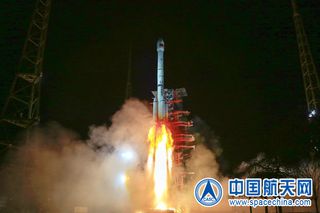ICYMI: China Has Launched 2 Rockets So Far This Year, Placing 5 Satellites in Orbit

The China National Space Administration has launched two rockets so far in 2019, placing five satellites in orbit for a variety of uses.
China's first space mission of the year lauched Jan. 11, with a Long March 3B rocket carrying the Zhongxing-2D communications satellite into orbit from the country's Xichang Satellite Launch Center in the Sichuan Province. The satellite will provide transmission services for the country's radio and television networks, according to the China Academy of Sciences.

A Long March 11 rocket launched four more satellites for China on Jan. 22, lifting off from the Jiuquan Satellite Launch Center in the country's northwestern Gansu province. That mission carried two "multispectral imaging" satellites with China's Jilin-1 satellite family, according to the state-run Xinhua news service. The new satellites join 10 other Jilin-1 satellites already in orbit to provide "remote sensing data and services for forestry, shipping and resource, and environmental monitoring," Xinhua reported.
The Long March 11 also carried two other test satellites into orbit, according to Xinhua. They include Lingque-1A, an Earth-imaging and communications satellite prototype built for the Beijing ZeroG Technology Co. for a planned constellation. The second test satellite is called Xiaoxiang-1 03 and is a demonstration unit to "verify radio communication and small remote sensing experiments" for its builder Spacety Co., Xinhua reported.
Both launches come on the heels of China's historic Chang'e 4 landing on the far side of the moon on Jan. 2. The solar-powered Chang'e 4 lander and its Yutu-2 rover snapped amazing photos of the moon's far side, and even grew the first plants on the moon before pausing to wait out the 14-day night cycle on the lunar surface.
Email Tariq Malik at tmalik@space.com or follow him @tariqjmalik. Follow us @Spacedotcom and Facebook.
Get the Space.com Newsletter
Breaking space news, the latest updates on rocket launches, skywatching events and more!
Join our Space Forums to keep talking space on the latest missions, night sky and more! And if you have a news tip, correction or comment, let us know at: community@space.com.

Tariq is the Editor-in-Chief of Space.com and joined the team in 2001, first as an intern and staff writer, and later as an editor. He covers human spaceflight, exploration and space science, as well as skywatching and entertainment. He became Space.com's Managing Editor in 2009 and Editor-in-Chief in 2019. Before joining Space.com, Tariq was a staff reporter for The Los Angeles Times covering education and city beats in La Habra, Fullerton and Huntington Beach. In October 2022, Tariq received the Harry Kolcum Award for excellence in space reporting from the National Space Club Florida Committee. He is also an Eagle Scout (yes, he has the Space Exploration merit badge) and went to Space Camp four times as a kid and a fifth time as an adult. He has journalism degrees from the University of Southern California and New York University. You can find Tariq at Space.com and as the co-host to the This Week In Space podcast with space historian Rod Pyle on the TWiT network. To see his latest project, you can follow Tariq on Twitter @tariqjmalik.
